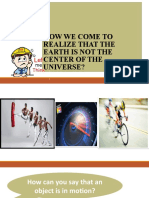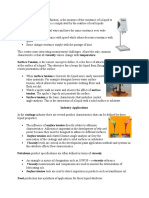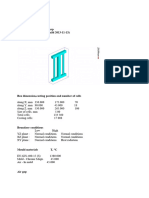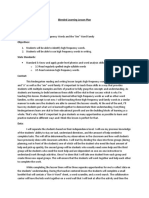0 ratings0% found this document useful (0 votes)
80 viewsHow We Come To Realize That The Earth Is Not The Center of The Universe
How We Come To Realize That The Earth Is Not The Center of The Universe
Uploaded by
stevenlloyd maybituinThe document discusses how ancient Greek philosophers and astronomers came to realize that the Earth is not the center of the universe. It explains that the Greeks knew the Earth was spherical based on Aristotle's observations that pieces of Earth converge into a sphere under gravity, southern constellations appear higher in the sky when traveling south, and the round shadow of Earth during lunar eclipses. The document also outlines key models of the universe proposed by thinkers like Eudoxus, Aristotle, Aristarchus, Ptolemy, and Copernicus that eventually led to abandoning the Ptolemaic geocentric model in favor of the Copernican heliocentric model through the discoveries of scientists like Galileo and Kepler.
Copyright:
© All Rights Reserved
Available Formats
Download as PPTX, PDF, TXT or read online from Scribd
How We Come To Realize That The Earth Is Not The Center of The Universe
How We Come To Realize That The Earth Is Not The Center of The Universe
Uploaded by
stevenlloyd maybituin0 ratings0% found this document useful (0 votes)
80 views27 pagesThe document discusses how ancient Greek philosophers and astronomers came to realize that the Earth is not the center of the universe. It explains that the Greeks knew the Earth was spherical based on Aristotle's observations that pieces of Earth converge into a sphere under gravity, southern constellations appear higher in the sky when traveling south, and the round shadow of Earth during lunar eclipses. The document also outlines key models of the universe proposed by thinkers like Eudoxus, Aristotle, Aristarchus, Ptolemy, and Copernicus that eventually led to abandoning the Ptolemaic geocentric model in favor of the Copernican heliocentric model through the discoveries of scientists like Galileo and Kepler.
Original Title
PhySci
Copyright
© © All Rights Reserved
Available Formats
PPTX, PDF, TXT or read online from Scribd
Share this document
Did you find this document useful?
Is this content inappropriate?
The document discusses how ancient Greek philosophers and astronomers came to realize that the Earth is not the center of the universe. It explains that the Greeks knew the Earth was spherical based on Aristotle's observations that pieces of Earth converge into a sphere under gravity, southern constellations appear higher in the sky when traveling south, and the round shadow of Earth during lunar eclipses. The document also outlines key models of the universe proposed by thinkers like Eudoxus, Aristotle, Aristarchus, Ptolemy, and Copernicus that eventually led to abandoning the Ptolemaic geocentric model in favor of the Copernican heliocentric model through the discoveries of scientists like Galileo and Kepler.
Copyright:
© All Rights Reserved
Available Formats
Download as PPTX, PDF, TXT or read online from Scribd
Download as pptx, pdf, or txt
0 ratings0% found this document useful (0 votes)
80 views27 pagesHow We Come To Realize That The Earth Is Not The Center of The Universe
How We Come To Realize That The Earth Is Not The Center of The Universe
Uploaded by
stevenlloyd maybituinThe document discusses how ancient Greek philosophers and astronomers came to realize that the Earth is not the center of the universe. It explains that the Greeks knew the Earth was spherical based on Aristotle's observations that pieces of Earth converge into a sphere under gravity, southern constellations appear higher in the sky when traveling south, and the round shadow of Earth during lunar eclipses. The document also outlines key models of the universe proposed by thinkers like Eudoxus, Aristotle, Aristarchus, Ptolemy, and Copernicus that eventually led to abandoning the Ptolemaic geocentric model in favor of the Copernican heliocentric model through the discoveries of scientists like Galileo and Kepler.
Copyright:
© All Rights Reserved
Available Formats
Download as PPTX, PDF, TXT or read online from Scribd
Download as pptx, pdf, or txt
You are on page 1of 27
How we come to realize
that the earth is not the
center of the universe.
Objectives
1. explain what the Greeks considered to be the three types of terrestrial motion
2. explain what is meant by diurnal motion, annual motion, precession of the equinoxes
3. explain how the Greeks knew that the Earth is spherical
4. explain how Plato’s problem of “Saving the Appearances” constrained Greek models of the
Universe
5. compare and contrast the models/descriptions of the universe by Eudoxus, Aristotle,
Aristarchus, Ptolemy, and Copernicus
6. cite examples of astronomical phenomena known to astronomers before the advent of
telescopes
7. compare and contrast explanations and models of astronomical phenomena (Copernican,
Ptolemaic, and Tychonic)
8. explain how Galileo’s astronomical discoveries and observations
(lunar craters, phases of Venus, moons of Jupiter, sun spots,
supernovas, the apparently identical size of stars as seen through the
naked eye, and telescope observations) helped weaken the support for
the Ptolemaic model.
9. explain how Brahe’s innovations and extensive collection of data in
observational astronomy paved the way for Kepler’s discovery of his
laws of planetary motion
10. apply Kepler’s 3rd law of planetary motion to objects in the solar
system
science
“a collection of known truths
about the Universe that develops
and expands over time.”
Why is SCIENCE dynamic
and ever-changing?
Astronomy is a major
influence to the
development of Physics.
That is why we discuss
ancient Greek philosophy,
cosmology and astronomy. The
Greeks divided the universe into
domains, the celestial domain and
the terrestrial domain.
Three types of Motion (according to greeks)
The classical Greeks in their philosophy regarded
the three types of terrestrial motion as:
1.Motion in respect to quality;
2.Motion in respect to quantity;
3.Motion in respect to place.
Motion with respect to quality –
Motion in respect of Quality let us call alteration, a general
designation that is used to include both contraries: and by Quality
I do not here mean a property of substance (in that sense that
which constitutes a specific distinction is a quality) but a passive
quality in virtue of which a thing is said to be acted on or to be
incapable of being acted on.
Motion relating to quality, e.g., from green to brown, is alteration.
Motion with respect to quantity –
Motion in respect of Quantity has no name that
includes both contraries, but it is called increase or
decrease according as one or the other is designated:
that is to say motion in the direction of complete
magnitude is increase, motion in the contrary direction
is decrease.
Motion relating to quantity, from large to small or small
to large, is decrease or increase.
Motion with respect to place –
Motion in respect of Place has no name either general
or particular: but we may designate it by the general
name of locomotion, though strictly the term
'locomotion' is applicable to things that change their
place only when they have not the power to come to a
stand, and to things that do not move themselves
locally.
motion in terms of locomotion, that is, motion from
one place to another or repetitive motion, such as
circular motion.
Substantial Motion
• Substantial motion is coming to be or passing
away: the development of an embryo to viable
infant to adult is an example of coming to be in
the category of substance. The change of clay
into a pot is different from, but analogous to, the
substantial motion that occurs in the
development of living organisms.
Explain what is meant by diurnal motion,
annual motion, precession of the equinoxes.
Diurnal Motion
Diurnal motion is the daily motion of stars and other
celestial bodies across the sky. This motion is due to the
Earth's rotation from west to east, which causes celestial
bodies to have an apparent motion from east to west.
Annual Motion
Over the course of a year, the
Sun appears to move a little
towards the East each day as
seen with respect to the
background stars. This daily
eastward drift is <1° per day
(there are 365 days in a year, but
only 360° in a circle). This
apparent motion is a reflection of
the Earth's annual orbit around
the Sun.
• Precession of the equinoxes
• Earth's precession was historically called the precession of the equinoxes,
because the equinoxes moved westward along the ecliptic relative to the
fixed stars, opposite to the yearly motion of the Sun along the ecliptic
H OW THE GREEKS KNEW
THAT THE EARTH IS
SPHERICAL ?
GREEK
HISTORY
Itall started as a
philosophical concept
developed by the Greeks
around the 6th century BC. It
wasn’t until the 3rd century
BC when Hellenistic
astronomy came to the
conclusion that the earth was
in fact physically spherical.
At first, there was no
real explanation of
how the Greeks came
up with this
conclusion, other than
their observation on
the change of the
stars when they
traveled.
Pythagoras and Plato taught
their students that the world was
round but they had no justification
or proof.
The round Earth
theory didn't get a
proper explanation
until Aristotle (384-
322 BC) made three
important
observations:
ARISTOTL IMPORTANT OBSERVATIONS:
E Every portion of the Earth tends
toward the center until by
compression and convergence
they form a sphere.
Travelers going south see
southern constellations rise
higher above the horizon; and
The shadow of Earth on the
Moon during a lunar eclipse
is round.
This knowledge was then passed from generation to
generation.
It was then spread to the eastern world where they thought
that the earth was a flat disk floating in an ocean surrounded by
a spherical sky, as explained by the Mesopotamian mythology.
The Models of the Universe:
You might also like
- LESSON PLAN 1st Cot HopeDocument5 pagesLESSON PLAN 1st Cot HopeJunnel Mae Camacho Licor100% (1)
- Program Sample DepedDocument12 pagesProgram Sample DepedBen Gabriel MaghuyopNo ratings yet
- DanceexamDocument6 pagesDanceexamIvon Quirante CabalesNo ratings yet
- Cheerdance What Is Cheerdance?Document5 pagesCheerdance What Is Cheerdance?Jerico VasquezNo ratings yet
- Perdev Week 3 q1Document5 pagesPerdev Week 3 q1arianneNo ratings yet
- DLP PS5Document2 pagesDLP PS5Cecille DelgadoNo ratings yet
- 2ND Quarter Periodical Exam Pointers To Review in Pe 3Document9 pages2ND Quarter Periodical Exam Pointers To Review in Pe 3Benedict Joshua S. DiaganNo ratings yet
- March 5-9Document3 pagesMarch 5-9kimberlyn100% (1)
- Q2 - Quiz 1-MEDIA AND INFORMATION LITERACYDocument3 pagesQ2 - Quiz 1-MEDIA AND INFORMATION LITERACYDaniella Anne PinoteNo ratings yet
- Performance Task #3 - 2nd Quarter ELSDocument2 pagesPerformance Task #3 - 2nd Quarter ELSKrisna Cortes FernandezNo ratings yet
- Adolescent Reproductive HealthDocument13 pagesAdolescent Reproductive HealthJohn Lester M. Dela CruzNo ratings yet
- Practical Research 1 Remediation 3rd QuarterDocument3 pagesPractical Research 1 Remediation 3rd QuarterAbigael L. Marveda - Eva100% (1)
- Earth & Life ScienceDocument23 pagesEarth & Life ScienceBella ManaloNo ratings yet
- 12 - Creativity: Camarines Norte Senior High SchoolDocument77 pages12 - Creativity: Camarines Norte Senior High SchoolbltrnNo ratings yet
- Understanding Culture, Society and PoliticsDocument14 pagesUnderstanding Culture, Society and PoliticsAries LuNo ratings yet
- Module 1 QTR How We Come To Realize That TheDocument13 pagesModule 1 QTR How We Come To Realize That TheFrennyNo ratings yet
- DLL - Ucsp - LC 1Document4 pagesDLL - Ucsp - LC 1MarkKevinAtendidoVidarNo ratings yet
- Moa Lgu LopezDocument6 pagesMoa Lgu LopezjohnpaulNo ratings yet
- Catch Up Friday Physical ScienceDocument24 pagesCatch Up Friday Physical ScienceMehca Ali SacayanNo ratings yet
- PERSONAL DEVELOPMENT Moule 1 To 4 Reviewer Key To CorectionDocument3 pagesPERSONAL DEVELOPMENT Moule 1 To 4 Reviewer Key To CorectionTin NatayNo ratings yet
- Second Sem Midterm DiagnosticDocument5 pagesSecond Sem Midterm DiagnosticChristoPher TorioNo ratings yet
- Science Grade 11Document142 pagesScience Grade 11venus caalemNo ratings yet
- SemesterDocument39 pagesSemesterESTEPHANIE TUMAGANNo ratings yet
- November 28, 2018Document3 pagesNovember 28, 2018Ma Alona Tan DimaculanganNo ratings yet
- Orange RpmsDocument54 pagesOrange RpmsRhodalyn EscarroNo ratings yet
- DRRR DLL 1 WeekDocument6 pagesDRRR DLL 1 WeekMichael Jhon Funelas MinglanaNo ratings yet
- Based On Annex 2B.6 To Deped Order No. 42, S. 2016: Daily Lesson Log Senior High SchoolDocument2 pagesBased On Annex 2B.6 To Deped Order No. 42, S. 2016: Daily Lesson Log Senior High SchoolMyra Dacquil AlingodNo ratings yet
- DLL Quarter 1 Week 1 Earth ScienceDocument4 pagesDLL Quarter 1 Week 1 Earth ScienceMary Jean BalentozaNo ratings yet
- Curriculum Guide: Instructional PlanningDocument3 pagesCurriculum Guide: Instructional PlanningBowina KhoNo ratings yet
- Entrep Week 7Document6 pagesEntrep Week 7Vergil MontemayorNo ratings yet
- Weekly Home Learning Plan For Grade 12 ICT PAGE (Second Semester, Quarter 1 - Week 1)Document4 pagesWeekly Home Learning Plan For Grade 12 ICT PAGE (Second Semester, Quarter 1 - Week 1)Sarah Jane Puerin MaurilloNo ratings yet
- Perdev LessonsDocument49 pagesPerdev LessonsRecel AnnNo ratings yet
- WLP Week1Document6 pagesWLP Week1Severus S PotterNo ratings yet
- Culminating ActivityDocument3 pagesCulminating ActivityJane HembraNo ratings yet
- Local Guiding Services NC II CGDocument10 pagesLocal Guiding Services NC II CGGILBERT JERRY AGUILARNo ratings yet
- Earth and Life ScienceDocument25 pagesEarth and Life ScienceJonathan MercadoNo ratings yet
- DLL Perdev ChallengesDocument3 pagesDLL Perdev ChallengesRemedios UntalanNo ratings yet
- Life Science 11A S.Y: 2019-2020 Second Longtest: Abm-KumoDocument2 pagesLife Science 11A S.Y: 2019-2020 Second Longtest: Abm-KumoMichael MangahasNo ratings yet
- Tech Voc TrackDocument30 pagesTech Voc TrackJoyce AlcoverNo ratings yet
- Ecr Grade 11 and 12Document92 pagesEcr Grade 11 and 12Marliel Paguiligan CastillejosNo ratings yet
- Els Week 17Document2 pagesEls Week 17alvinPaboresNo ratings yet
- Stem Gc11s Ie 30Document3 pagesStem Gc11s Ie 30Dondon TayabanNo ratings yet
- Session 1 Session 2 Session 3 Session 4: I. ObjectivesDocument3 pagesSession 1 Session 2 Session 3 Session 4: I. ObjectivesSherwin SantosNo ratings yet
- Per Dev Week 1Document6 pagesPer Dev Week 1Andrey DyNo ratings yet
- Mil DLL Oct. 16 20 Grade 12Document4 pagesMil DLL Oct. 16 20 Grade 12Anny BabaoNo ratings yet
- Biological Macromolecules 6-Day Lesson PlanDocument6 pagesBiological Macromolecules 6-Day Lesson Planapi-525524929No ratings yet
- Lesson Exemplar School Grade Level Teacher Learning Area: V Tgsvkjqxq5A&List Pl9Lhtzfmlpdho0K - Tvwwgy19N7Hiwf2Es&Index 11Document4 pagesLesson Exemplar School Grade Level Teacher Learning Area: V Tgsvkjqxq5A&List Pl9Lhtzfmlpdho0K - Tvwwgy19N7Hiwf2Es&Index 11Montano L. Agudilla JrNo ratings yet
- Emely Final Demo Lesson Plan June 26Document5 pagesEmely Final Demo Lesson Plan June 26Emely CarroNo ratings yet
- My Study Note: Ms. Laurice A.OlegarioDocument42 pagesMy Study Note: Ms. Laurice A.OlegarioLaurice Olegario100% (22)
- HG Week 5&6Document25 pagesHG Week 5&6Lielanie NavarroNo ratings yet
- Peh12 - Week 1 To 3Document7 pagesPeh12 - Week 1 To 3Shiela MaeNo ratings yet
- Perdev DLP 2Document3 pagesPerdev DLP 2Roy DoleraNo ratings yet
- psdll11 28 18Document2 pagespsdll11 28 18Christine De San JoseNo ratings yet
- FINAL COOKERY9 Q1 W3 Clean and Maintain Kitchen Tools Equipment and PremisesDocument4 pagesFINAL COOKERY9 Q1 W3 Clean and Maintain Kitchen Tools Equipment and PremisesDyəm MęępoNo ratings yet
- Lesson Guide in Earth and Life Science I. ObjectivesDocument2 pagesLesson Guide in Earth and Life Science I. ObjectivesJT SaguinNo ratings yet
- UCSP DLL 1st WKDocument3 pagesUCSP DLL 1st WKRheena-Ann Dupale PadillaNo ratings yet
- Edited Session 11Document3 pagesEdited Session 11JuneNo ratings yet
- BPP Lesson 2 DLLDocument5 pagesBPP Lesson 2 DLLmyra ceradoNo ratings yet
- How We Come To Realize That The Earth Is Not The Center of The Universe?Document51 pagesHow We Come To Realize That The Earth Is Not The Center of The Universe?Mary Joy Llosa Redulla100% (1)
- HST204 Week 02 the Birth of AstronomyDocument29 pagesHST204 Week 02 the Birth of Astronomyat23170No ratings yet
- Stoichiometry: Atomic Mass, Avogadro's Number, Mole ConceptDocument30 pagesStoichiometry: Atomic Mass, Avogadro's Number, Mole Conceptstevenlloyd maybituin100% (1)
- The Insecticidal Potency of Nee-Gano (Neem, Azadirachta Indica OreganoDocument9 pagesThe Insecticidal Potency of Nee-Gano (Neem, Azadirachta Indica Oreganostevenlloyd maybituinNo ratings yet
- Paints Because They Must Be Designed To Adhere To Different SurfacesDocument4 pagesPaints Because They Must Be Designed To Adhere To Different Surfacesstevenlloyd maybituinNo ratings yet
- Mole ConceptDocument15 pagesMole Conceptstevenlloyd maybituinNo ratings yet
- Naming Alkenes Worksheet 2 PDFDocument1 pageNaming Alkenes Worksheet 2 PDFstevenlloyd maybituinNo ratings yet
- DM 345 s2018Document27 pagesDM 345 s2018stevenlloyd maybituinNo ratings yet
- Ece 310Document10 pagesEce 310Arlyn AzzamNo ratings yet
- JETIR2306337Document19 pagesJETIR2306337hanluna897No ratings yet
- OTDR II Trace Option English Rev1 PDFDocument205 pagesOTDR II Trace Option English Rev1 PDFsorangel_123No ratings yet
- Karacic Tomislav SIM3Document7 pagesKaracic Tomislav SIM3jdjxisisNo ratings yet
- B04 - Guided Interpretation #4Document14 pagesB04 - Guided Interpretation #4Luis Camilo Gomez TrujilloNo ratings yet
- Invitation Sis - Offline Day 1Document4 pagesInvitation Sis - Offline Day 1rw11 dpk2No ratings yet
- Design & Technology G10 - 12-1Document43 pagesDesign & Technology G10 - 12-1vestalamumba85No ratings yet
- Unit 5 Mastery AssignmentDocument5 pagesUnit 5 Mastery Assignmentapi-664352672No ratings yet
- How To Describe People in EnglishDocument22 pagesHow To Describe People in EnglishZul ZuliyahNo ratings yet
- Dissertation Philo Nature Et CultureDocument4 pagesDissertation Philo Nature Et CultureWriteMyEnglishPaperForMeSterlingHeights100% (1)
- Catechol ToksisitasDocument2 pagesCatechol ToksisitasRisa NurrahwaniNo ratings yet
- Robot Degree of Freedom ConfigurationDocument56 pagesRobot Degree of Freedom ConfigurationHoney RathoreNo ratings yet
- De Unit II For Students-1Document39 pagesDe Unit II For Students-1pradnyasandbhor72No ratings yet
- Torrey LEQ-HS User ManualDocument19 pagesTorrey LEQ-HS User Manualelvismorey9721No ratings yet
- Differential Equations MathsDocument39 pagesDifferential Equations MathsBhavin PatelNo ratings yet
- Nursing Management Planning and OgranizationDocument2 pagesNursing Management Planning and OgranizationAndee SalegonNo ratings yet
- Eng 10 Q3 Mod2a 2BDocument4 pagesEng 10 Q3 Mod2a 2BElaina Duarte-SantosNo ratings yet
- Phases of The MoonDocument3 pagesPhases of The MooncyriaaNo ratings yet
- Sika Precast Technologies-CompressedDocument28 pagesSika Precast Technologies-CompressedAmar PalNo ratings yet
- Simple Harmonic Motion - Sohila NagebDocument82 pagesSimple Harmonic Motion - Sohila NagebNadine HabibNo ratings yet
- Dissertation Sur Un Coeur SimpleDocument7 pagesDissertation Sur Un Coeur SimpleWhereToBuyCollegePapersSingapore100% (1)
- MKT-000-00000973-EN Rev O Physical Medicine Modalities DIGITALDocument40 pagesMKT-000-00000973-EN Rev O Physical Medicine Modalities DIGITAL徐恩量No ratings yet
- Marketing Management: Prof Seeboli GhoshDocument171 pagesMarketing Management: Prof Seeboli GhoshSeeboli GhoshNo ratings yet
- The Effect of Rider's Passive Steering Impedance On Motorcycle Stability: Identification and AnalysisDocument14 pagesThe Effect of Rider's Passive Steering Impedance On Motorcycle Stability: Identification and AnalysisJoan Ferrao GenescàNo ratings yet
- Assure Model Instructional PlanDocument2 pagesAssure Model Instructional PlanAndrea Marie S. GayloaNo ratings yet
- Workplace Safety and Health (General Provisions) RDocument76 pagesWorkplace Safety and Health (General Provisions) RRamesh-NairNo ratings yet
- Leading InnovationDocument8 pagesLeading InnovationIvan Jon FerriolNo ratings yet
- Literature Review of Blue BrainDocument4 pagesLiterature Review of Blue Brainc5ng67v1100% (1)
- NCERT Class 12 Geography of India Chapter 6 Water Resources YouTube Lecture Handouts Part 1Document6 pagesNCERT Class 12 Geography of India Chapter 6 Water Resources YouTube Lecture Handouts Part 1Student UseNo ratings yet
- MatchDocument4 pagesMatchLeader KidzNo ratings yet































































































